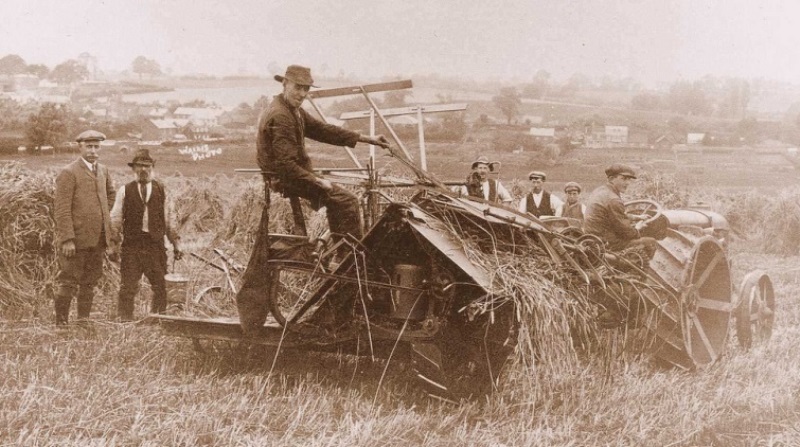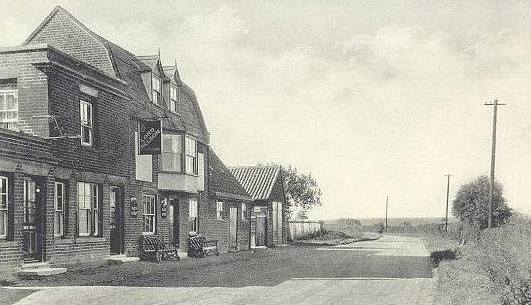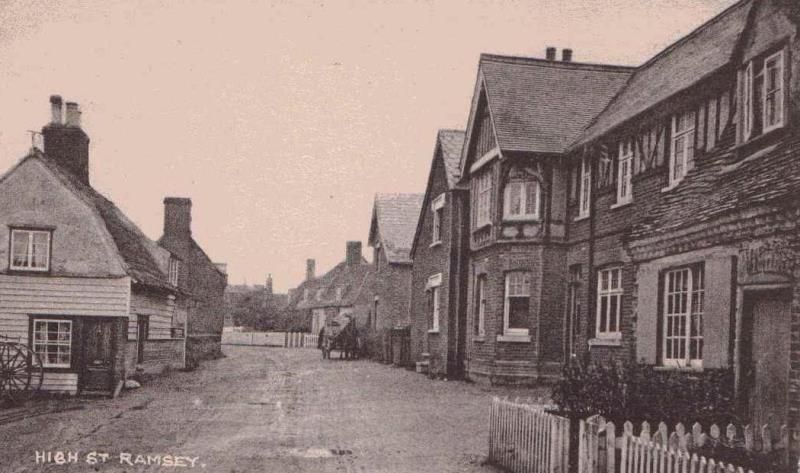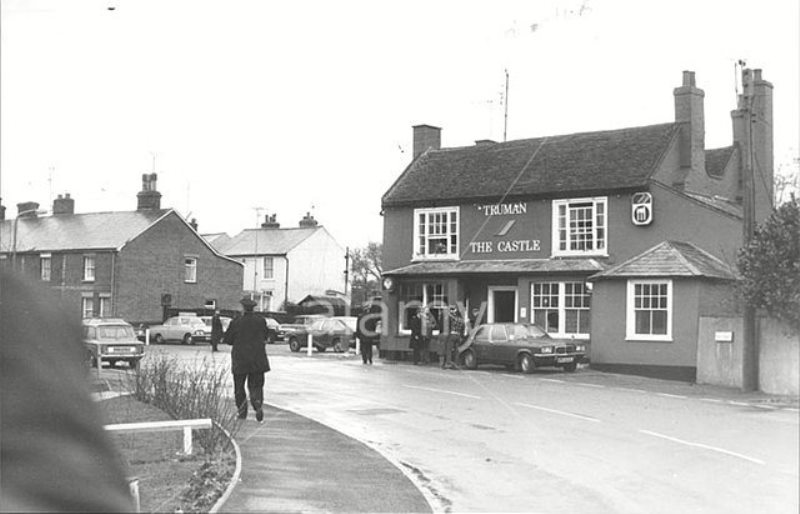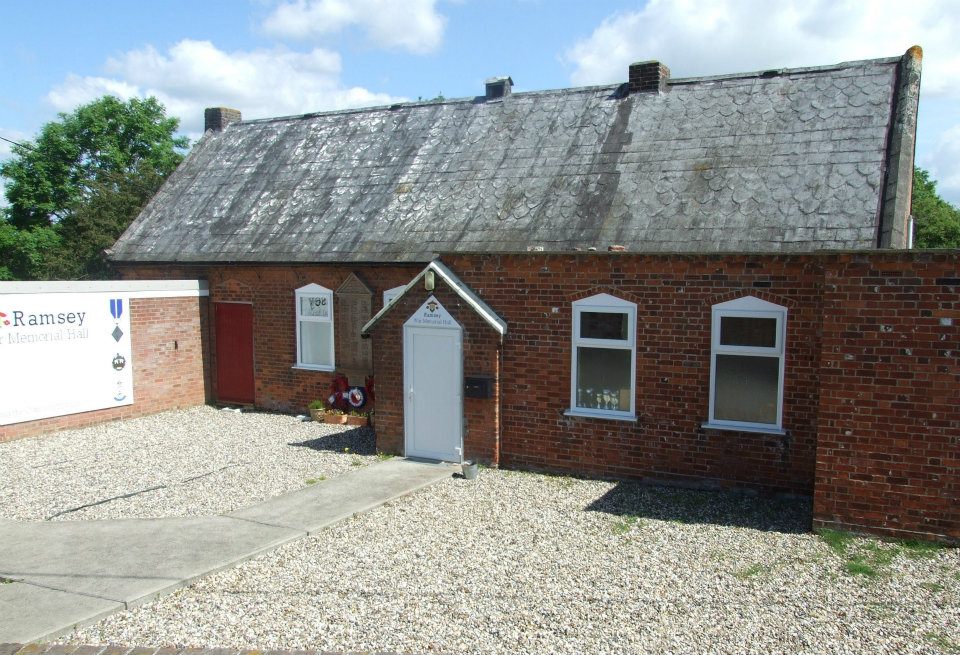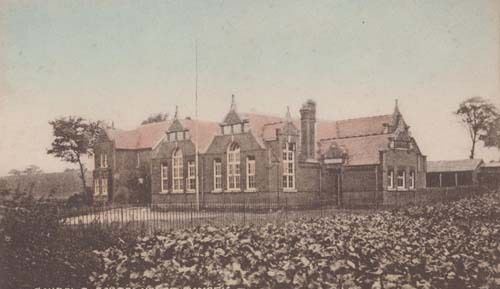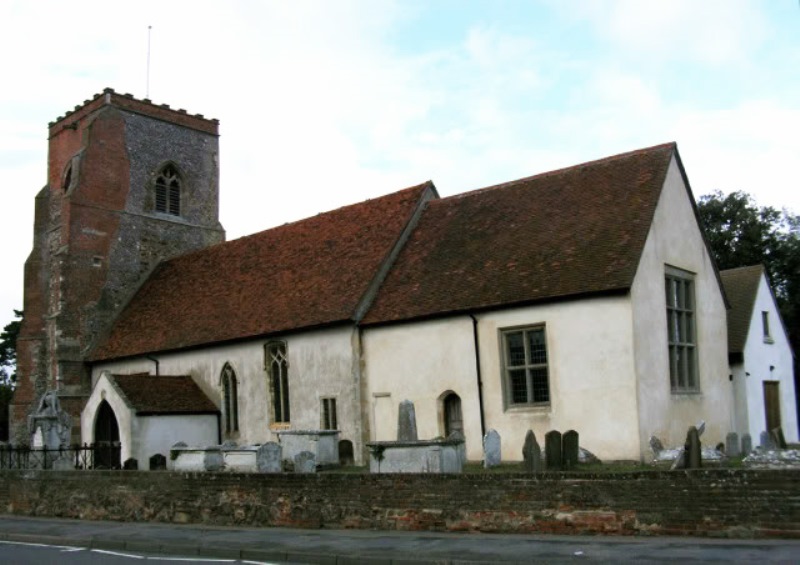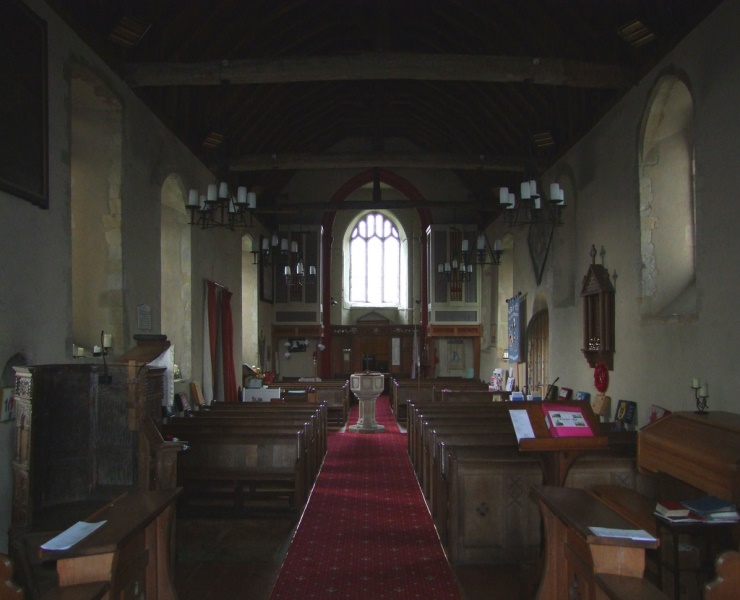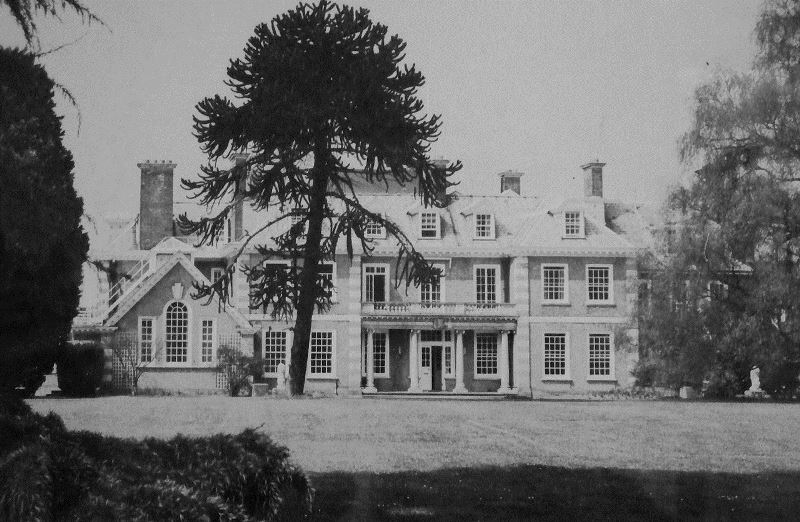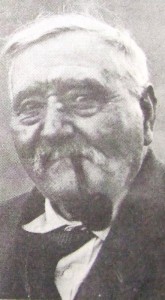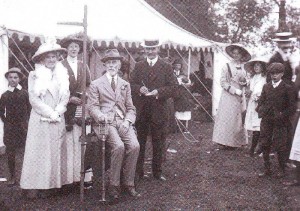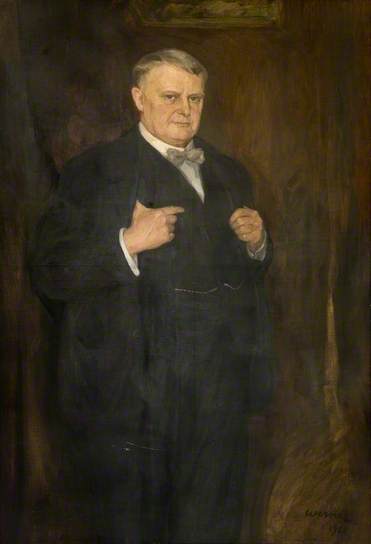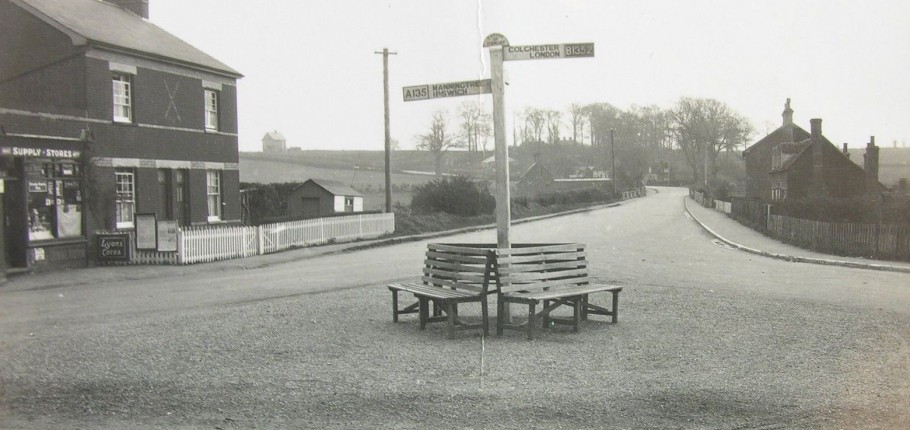
Ramsey
The Village of Ramsey stretches from the sea to the banks of the River Stour and stands a stride both of the main roads into Harwich so that all travelers by road or rail to or from the port must pass through it. It is fascinating to consider the multitude of historical personages, famous and infamous, who have looked out of their coaches or carriages on to this fair parish with its church crowning the highlight point on the hill.

Ramsey Village
Yet how many people who rush through the village ever pause there in order to discover something of its past? for Ramsey certainly has several claims to attention and even in itself as it exists today there is a decided attraction. Other manors in Ramsey were known as Ramsey Hall, East Hall, Ray and Foulton, and perhaps the most interesting of these is the last, for even in the Domesday Book we find Foulton Manor mentioned, when it seems to have been dignified by the title of hamlet.
And it was in this hamlet that Ramsey’s other house of worship existed, the adowson of which was endowed with quite a considerable extent of land, besides ‘the first mowing of one acre in Foulton Marsh, and feet in that Marsh for 50 sheep’. Therefore, although we discover that the vicar of Ramsey was ‘obliged’ to conduct divine service in Foulton Chapel, this seems to have been a religious establishment of an importance rather beyond the ordinary.
Like so many places of a similar nature, however the chapel at Foulton has long been demolished, and not even a ragged piece of masonry remains to tell of its whereabouts.
Buildings of Architectural Interest
Bridgefoot Farm
This house was built early in the 16th century and refaced with modern brick later. The doorway has moulded jambs and head carved with spiral leaf pattern. Inside the building the North East room has some original and moulded carved ceiling beams and moulded joists. Another room at the back also has a moulded beam and joists.
White House Farm
Built early in the 16th century with a cross wing at the south west end. Inside is an original moulded ceiling beam and at the back, an original window of four lights now blocked.
Mill Farm
Built in the late 16th century. The walls are of original brick except the South East side which is modern. On the North West front are two gables with moulded corbelling to the base of the parapets and octagonal pinnacles at the apex. The porch on this side has an original embattled parapet and a doorway with chamfered jambs, a two-centred arch with a moulded label. Two windows in the gables have original moulded labels. The house takes its name from the tidal water-mill that used to stand nearby.
The Ramsey Tide Mill
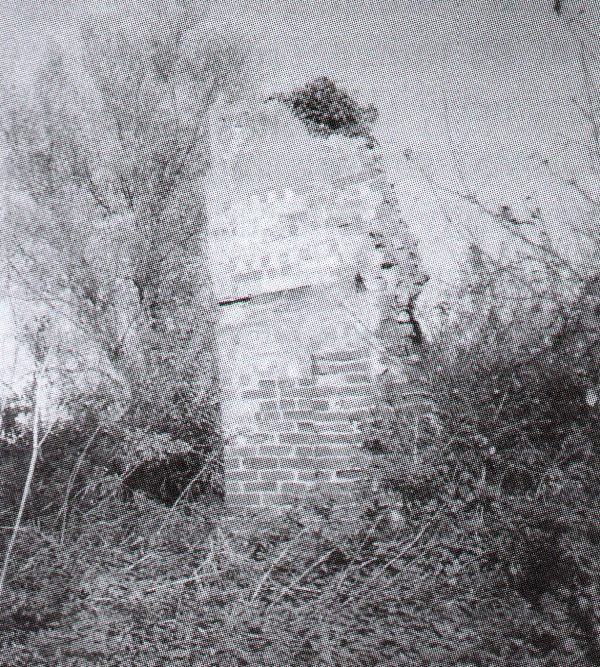
Ramsey Tide Mill
The picture shows the rural scene whilst on a walk down Rectory Lane, which starts in Rectory Road, Little Oakley, beside the Rectory, and ends near the roundabout at the foot of Church Hill, Ramey. This lane is an ancient bridle path connecting the two villages with its lower end following the course of Ramsey River. These bricks are all that remains of the chimney and chimney breast once part of the Miller’s House which stood beside the Tide Mill and straddled the small stream flowing beneath it. These bricks, rising from the weeds, nettles and brambles, are a part of Ramsey’s social history and reminds us of the day to day working life of our forebears, stretching back for centuries. Without a Tide Mill a windmill was needed and the first was built almost immediately, for village life goes on and corn must be ground for our daily bread.
Ramsey Windmill
Originally built in Woodbridge, Suffolk. The mill was moved to Ramsey in 1842 by Henry Collins, millwright of Woodbridge. The mill was working until the Second World War, and then left to deteriorate until 1974 when the owner, Mr Michael Organ, set about restoring the mill. Members of the Suffolk Mills Group assisted with work on Ramsey Windmill between 1974 and 1978. the Windmill is a post mill with a three story roundhouse, winded by a roof mounted fantail and has four double Patent sails. There are two pairs of millstones in the breast and a third pair in the tail. The trestle is of oak. the main post is 17 feet 6 inches in length, 27 inches square at its base. The mill was built with a roundhouse from the start. The body of the mill measures 16 feet by 10 feet 4 inches in plan, the mill is 48 feet 6 inches high overall, the wooden Head Wheel is of clasp arm construction, 7 feet 3 inches diameter, with 90 cogs of 3 inches pitch.
It drives two pairs of overdrift French Burr millstones via a cast iron Wallower and Spur Wheel. The cast iron Tail Wheel is 4 feet diameter. It drives a single pair of underdrift 3 feet 4 inches diameter millstones via an Upright Shaft and Spur wheel.
Ramsey Windmill was winded by a six-bladed roof mounted fantail, which blew off in 1939. The drive was down the back of the mill and thence to a ring set above the join of the quarter bars to the main post.
Harvest at Hill House Farm at Ramsey,although tractors were about around the First World War, they were not taken up much until the end of the decade.
This Reaper Binder at Ramsey is being pulled by a tractor rather than horses. Mr. Hewitt, on the left, the farmer is joined by six of his farm labourers.
Village Life
Bakers
The village bakers were run by Mr Farrington, when he passed away it was taken over by his son, Fred who used to deliver bread around the village and district.
Blacksmiths
There were two Blacksmiths, One was nearly at the bottom of the hill and was owned an run by Mr Joe King, the other by Mr Ellis, His premises were in The Street and when he closed Mr Les Lewing had a butchers built on the site.
Builders
There were two builders, Lucas & Sons had a builder’s yard on land opposite Farrington’s shop and S Ellis had a builder’s yard on the corner opposite the Castle Inn. Mr Ellis was also the village undertaker, he had a horse drawn hearse, and his son Frank was also the church organist. Mr Ellis also had the village’s fire engine which was pulled by hand, both these where stored in a shed on his builder’s yard.
Mr Neal had a coal merchants business, he delivered coal around the village by horse and cart, and he lived in a small cottage with coal yard at the side of his house.
Public Houses and there Landlords
The small village only had 4 Public Houses, here lists the Landlords and Landladies, only the Castle Inn remains today.
Lord Nelson, Wrabness Road
Another of the village pubs, having its own nursery garden and orchard. It is believed the original name was the Nelson, later becoming the Nelson Head and finally the Lord Nelson when the Ward family were landlords.
- 1845-1891 William Ward
- 1894-1898 George William Barker
- 1898-1905 Walter Thorpe
- 1906-1936 Charles Diaper
- 1937- John Goudge
The pub closed in 1961 and is now a private house & listed building – first recorded as an unnamed licensed premises in 1845, when it also served as a post office.
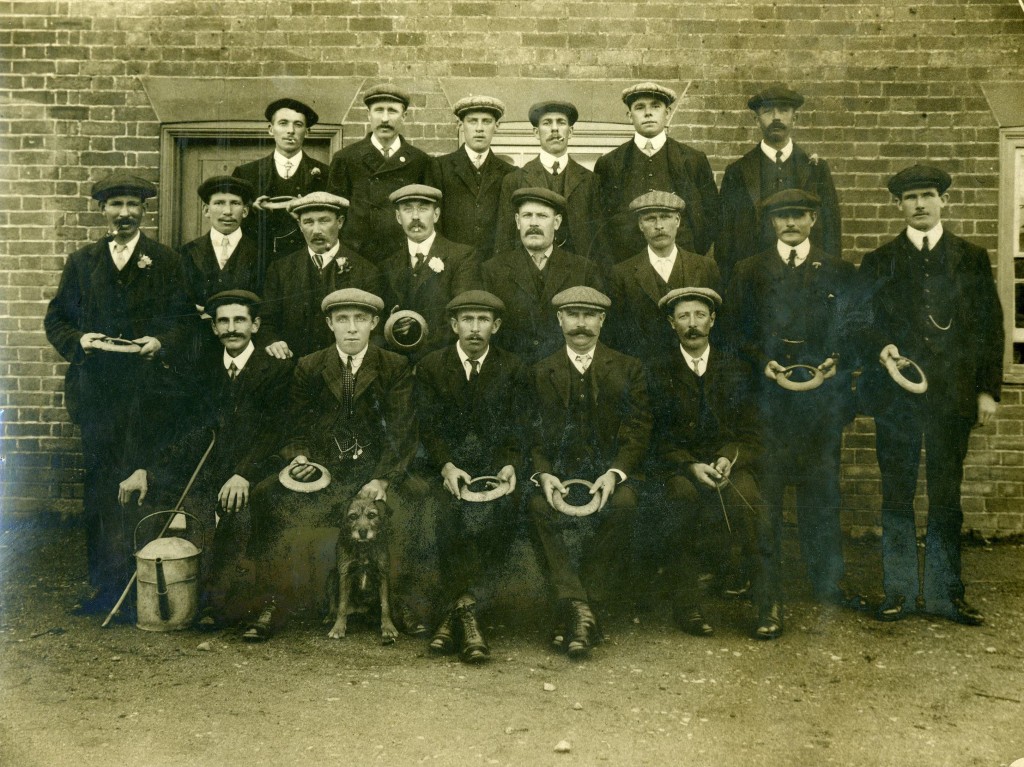
Lord Nelson Quoits Team
There have been many competitive games in village life centred on the “local”; one of those, once very popular but now almost forgotten, is the game of “quoits”.
In the first half of the century quoits was played near many a pub up and down the country and numerous village inns had a “pug match” close at hand.
The games of “quoits” is played with a heavy sharp iron ring, or quoit, weighting between 7 and 9lbs. The quoit is pitched over as near as possible to an iron “hob” from 18 yards distance where one finds a second “hob”. A bed of clay, sometimes circular but often square in shape, known as the “pug patch”, surrounds each “hob”, and play proceeds as in bowls from end to end. 2 points are given for a “ringer” and 1 point for the quoit nearest to the hob. Although not in the rules it was unusual for a “fag paper” to be stuck on the hob so that it could be seen clearly in the mud at 18 yards distance, and this paper was referred to as the “light”.
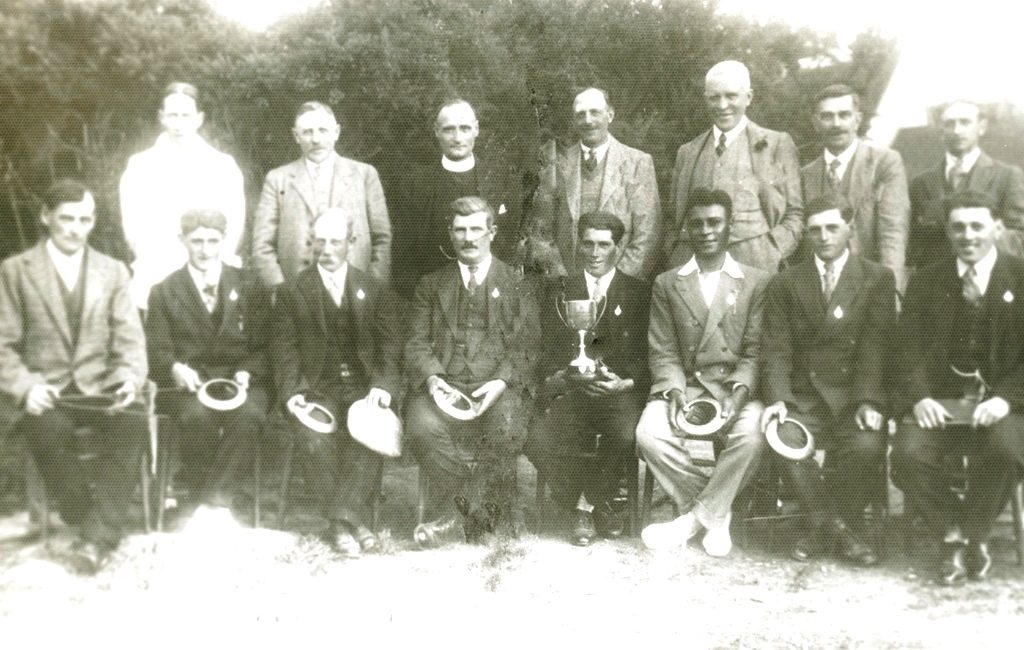
Ramsey Quoits Team 1930
Back Row:- Cyril Saunders, Steve Ellis, Rev. C.H. Pymont, Ernie Gosling, Arthur Goddard, Mount ?, Percy Farrington.
Front Row:- Tom Oswick, Fred Cole, Charlie Row, Charlie Deex, Bill Pryke, ‘Dido Ablett’, ‘Friday’ Bill Botten, Sidney Botten.
Prince of Wales, The Street
Trading in 1894 as a beer-house for Steward Patterson. Later to be known as the Gables, When the Prince of Wales closed half of it was tuned into a shop and the other half was let as a private dwelling.
Opposite stood the White Swan.
- 1871-1874 Mary Deex
- 1874-1917 Richard Deex
The White Swan, The Street
Previously known as the Feathers and traded from 1769 to 1814 as an ale-house. It was sold by Cobbold at auction in 1837 and is now a private house.”
1769-Joseph Webb
The Castle Inn, The Street
This charming Seventeenth century coaching inn with it’s saffron washed exterior and window boxes, is a firm favourite with locals and foreign visitors because of its good food, spacious been garden and well equipped children’s play area. t traded in 1769 as an ale-house and was sold by Cobbold in 1837 and was taken over by Alston’s of Manningtree. Later Charrington Nicoll then Daniel & Co, who were taken over Truman’s.
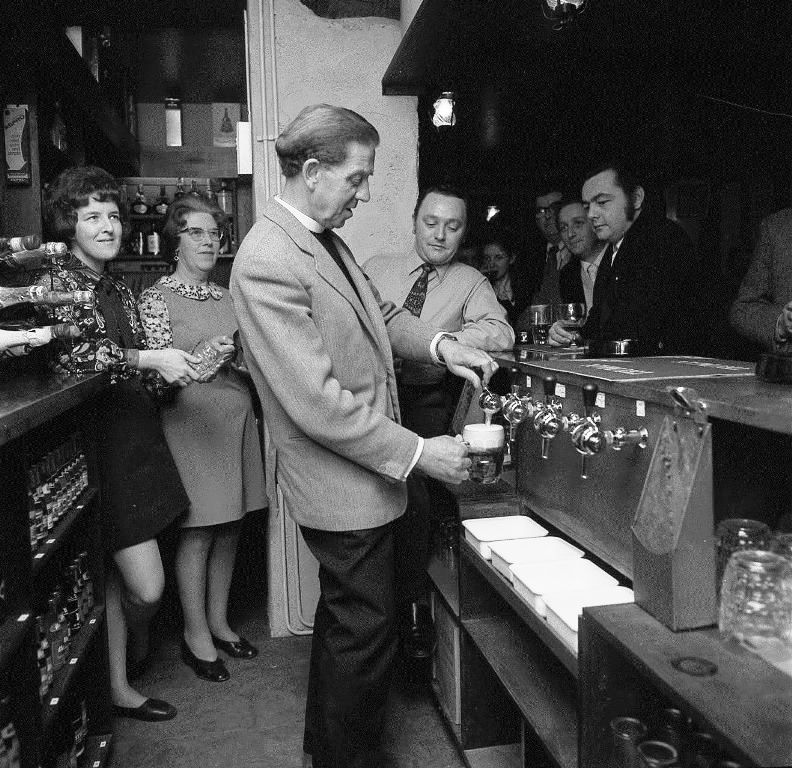
Rev Wood & Brian Rayner
- 1769- Susan Fairs
- 1839-1845 John Weaver
- 1845-1855 George Morley
- 1851-1862 Mary Morley
- 1862-1867 Edward Millichap
- 1867-1874 Joseph Sneezum
- 1874-1894 Stephen Ellis
- 1894-1912 Sarah Ellis
- 1912-1914 George Hood
- 1914-1917 Robert Sidney Scantlebury
- 1917-1923 Frederick Harris Ashe
- 1923- Harry Parkin
- 1925-1929 William Henry Perkins
- 1929- William John Pickrell
- 1968-1984 Brian Rayner
- 1984-1995 William & Marjorie Jackson
- 1995-1995 Steve & Carol ?
- 1995- Gordon & Joyce ?
- 1997-1998 Mick & Kath Renton
- 1998- Ray & Karen Baldry
- 2001- Ian & Val ?
- 2003- Tony McGarry
- 2007- Shirley Richardson
The Castle Inn Siege March 22 1979.
Crazed teenage gunman Paul Howe was shot dead by police as he made perverted “death or glory” bid to break out of a village pub.
The Drama had started in Chelmsford where Howe was being sought by police for questioning. Seizing Mr Ridley from his house. Howe forced him to drive during a 100- mile high speed chase through Essex and Suffolk. After failing in his attempt the gunman managed to grab an unguarded police transit van and break out of the dock. The chase came to an end when Howe decided to take over the castle, where he was rapidly pinned down and surrounded by police.
Howe was killed by a police marksman as he tried to shoot his way out of the Castle inn at Ramsey on Wednesday morning. He had already wounded one policeman before he was gunned down in the street outside.
The tearaway teenager – described as “wild” by friends – made his desperate last stand after a hostage he had held for 13 hours managed to escape. Howe set fire to the pub and ran shooting form the blazing building.
The Hostage 23 year old John Ridley, said after his ordeal that Howe had been determined to force the police to shoot him and had even set a time for his break out.
My Night of terror by siege hostage
Siege hostage John Ridley’s account of a night of terror in the hands of a crazed gunman. for a long time he was very reasonable towards me and we got on quite well, we were on first name terms.
“We talked and chatted about general things – we spent some time discussing different pubs we drank in at Chelmsford. We also talked a lot about him, and why he was taking me hostage.
“During the night I often tried to persuade him that the best way out of this problem was just to walk out of it and give himself up – but in the end it just didn’t work out.
“He didn’t really threaten me unless there were police around, when they were about he’d press the barrel of the shotgun against my neck. But the only time I was hurt was when I slightly injured my leg tumbling down some steps on the Harwich ferry”.
“Right up to when I escaped he said he would let me go at 7 am when he planned a shoot-out with the police, But he was getting so worked up towards the end I thought he might have got angry and had a go at me anyway, so I decided to escape.
Harwich and Manningtree Standard – Friday March 23 1979
“Paul Howe was described as a “real tearaway” – a boy with a dual personality”.
The Old Ramsey Church School.
Built in 1867 it was taken over by the Parkeston Board in October 1888.when the new Ramsey School was built the old school closed its doors on the 4th April 1901. The hall is now known as the Ramsey War Memorial. The hall is named after the famous war memorial in the Centre of Ramsey. This memorial depicts St George spearing a Dragon and was erected to pay tribute to the many local people of the Parish who lost their lives during World War I and World War II.
Ramsey War Memorial FC
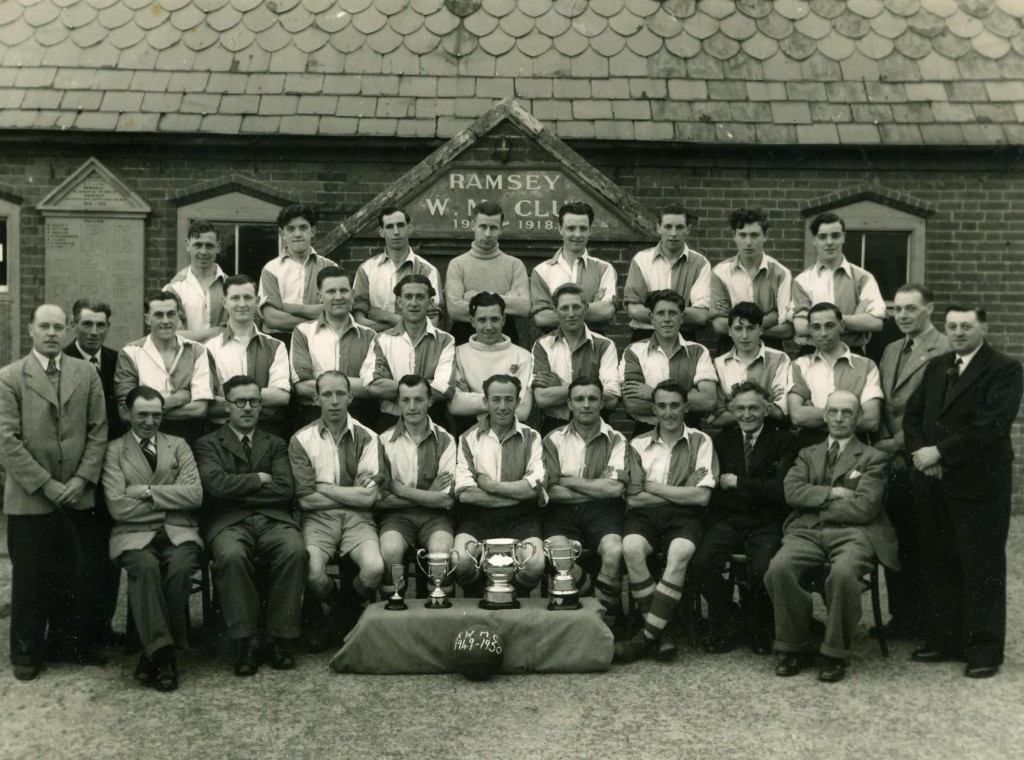
Ramsey FC
Ramsey War Memorial FC was founded in 1938 as part of the flourishing War memorial club still situated at the foot of Church Hill today and played on the adjacent recreation ground. WW2 quickly curtailed the clubs activities but it was soon reformed in the late forties competing in the Tendring Hundred League and local charity cups such as Walton and Manningtree. After several successful seasons the club moved on to the Colchester and East Essex League, securing promotion from Division 1 to the Premier Division at the first attempt.
The mid 50’s saw their most successful period with numerous cup finals and victories, as well as League Honours in successive seasons from 1953 to 1958. During that period they also reached the final of the Essex Junior Cup, however despite leading at half time they were defeated 2-1 by Rainham Old Boys at Halstead FC. Success in local cups continued with the Harwich Junior Charity Cup being captured several times.1963/4 saw the club in a nomadic existence as dredging work on the adjacent Dock River made the “Rec” unavailable and the several home matches were played at Warners Holiday Camp, with the chalets adjacent to the swimming pool serving as changing rooms whilst the puddles in the pool served as washing facilities.
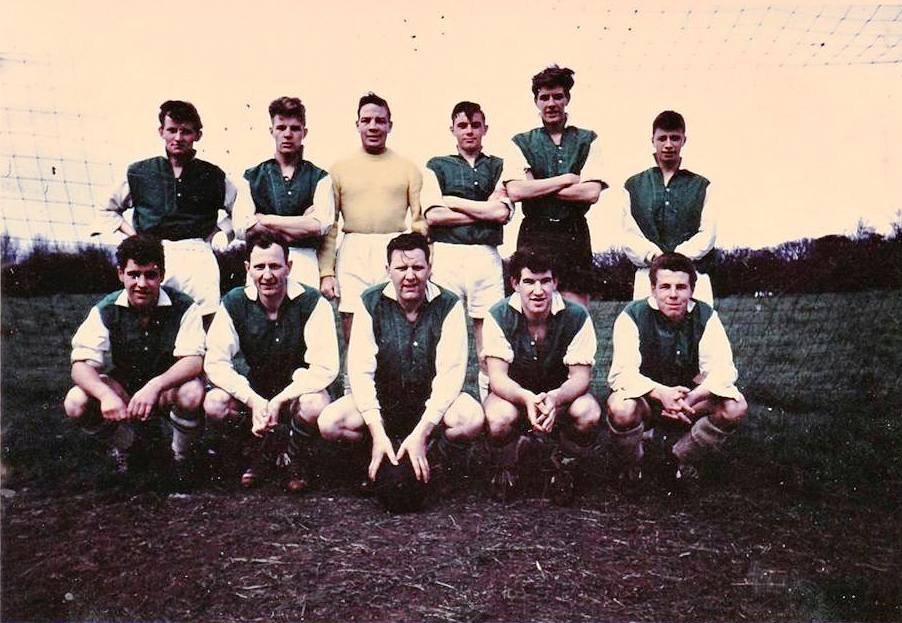
Ramsey FC 1960
At this time the War Memorial Club closed and the club became Ramsey FC. The Wivenhoe Charity Cup was won as the club played 5 games in 6 days including 2 cup semi-finals and finals, but indifferent league form saw them lose their Premier Division place. Further decline took place with Club sink to Division 3 by the end of the 1969/70 season. and further relegation was only avoided on the final match of the 70/71 season. Gradually the fortunes improved and the club rose up the league again and in the 1976/77 season reached the final of the Harwich Junior Charity Cup for the first time in over a decade losing 5-2 to Thorpe Sports, having won the Charles Wade Trophy in their first final appearance of that competition. The club again became nomadic as the arrival of stage 1 of the Dovercourt by pass ran almost goal to goal along the existing pitch and most home games were played at Wix or on the Strangers Home pitch at Bradfield. The early 80’s saw a return home to the new Recreation Field in Harwich Road and the club celebrated by finishing as runners up in Division one to regain their Premier Division place as well as a second Charlie Wade final appearance.
The return to the Premier Division saw them briefly top the table, but they were unable to maintain this and shuffled between Premier and Division 1 throughout the 80’s. One more Harwich Charity Cup final appearance came in 1984/5 season and further C Wade finals but no more silverware. 50 years was celebrated in 1988 when the club entertained a Colchester League XI defeating them by 2 goals to 1, but within 4 seasons a player shortage at the beginning of the 1992/3 season saw the club left with no alternative but to withdraw from the league and fold.
by Andrew Mills
Ramsey FC 1960 – (c) Emma Law
- Back row. Paul Copping Paul Bradford. Ray Simpson. Adrian Herd. Anthony Clifford. Roger Atkins
Front row. Johnny Baldry. Stanley Mills. Brian Mills. Bernie Sadler. Geoffrey Haxell.
School Life by Henry Allen
The Village of Ramsey can be described, roughly, as in the shape of a dumb-bell. Its top is wide with Wrabness on one side and Dovercourt on the other and its bottom part has Lt Oakley to the west and Dovercourt to the east. These two large parts of the village are joined together by a narrow corridor squeezed in the middle between Mayes Lane and lane through the old transit camp. On this particular day it was wet, a fine drizzle at times, and I remember it still.
Down the hill we went. It is now called Church Hill but for me it was be old Ramsey hill with sharp dip towards its foot, where newly built council houses on one side were looking across the road at Whinney wood and the village Blacksmith’s house and forge with its two fires glowing red and white with heat and Mr King, the blacksmith, pumping his bellows. guided by my cousins we passed the old village school (now the village hall). It bears a plaque with the names of Ramsey men who served in WW1, and behind it was the village football field.
The road turned north to cross the flood plain of the valley floor, with grassy meadows on both side and few tall gnarled ash and elms, my path was a sleepy country road that saw many a horse and cart along its twisting, turning, wriggling way: it was built for such traffic: during many a long year for the shepherd and farmer and for the cowman, it was the highway, the main road, the only road, but a safe road for a small boy on his first walk to school.
Soon we had crossed the bridge spanning the reed chocked river and hurrying towards Bridgefoot Farm and the Castle Inn. Ellis and Sons Builders. on the south side of the street were the Cellar houses, so called because they perched on the very edge of the valley with two or three steps immediately behind the front door leading down into the living room. although by necessity narrow the village street was still adequate for the horses and carts of rural life but not for cars and farm tractors that were just beginning to be used or for the bus and the daily Grey Green coach to and from London.
By now the school bell will be ringing as we hurry past a row of newly built semi-detached council houses, from which emerge some of my school friends and we pass through the school gate. For the first time I see this large building (in which my father was taught for the last two years of his academic life, 1908 to 1910. Beside it stands the school master’s house and behind the play area and football field I enter the school for the first time by the door marked ‘Girls and Infants’ and meet my golden haired teacher. This was the path I walked to and from school five days a week in all weathers until I learnt to ride a bicycle at about the age of eleven. It was then I discovered how steep old Ramsey hill really was.
St. Michael and All Angels Church
The Church dates back more than 900 years, the tower houses five bells and once had a clock together with a sundial on the south face. The Church is an ancient Gothic structure, with a square embattled tower, containing five bells. The chancel was rebuilt in 1597, and has an inscription in memory of Sir Thomas Davall, Kt., who was one of the representatives of Harwich in all the parliaments of King William, and the two first of Queen Anne. The church was appropriated to St. Osyth Priory.
The Discharged vicarage, valued in K.B. at £15, and in 1831 at £240, is in the patronage of the Lord Chancellor, and incumbency of the Rev. S.N. Bull, M.A., of Dovercourt. The great tithes belong to the landowners, and the vicarial tithes were commuted in 1847 for £300 per annum.
By 1938 the tower was in a poor state of repair and £3,000 was raised through fundraising some twenty years later, the west wall was demolished and rebuilt. By 1938 the tower was in a poor state of repair and £3,000 was raised through fundraising some twenty years later, the west wall was demolished and rebuilt. In February 1978 a new organ was installed built by G.T. Wilkins Ltd of Brightlingsea and was dedicated to the memory of Frank Ellis who had been the church organist for over half a century.
In the 12th Century, the main part of the original church was built. The north doorway and the small window to the right of it (as you look from the entrance porch) are Norman. In the 13th Century, the main part of the original church was improved in the Early English style. A picina, to hold Holy water (by the pulpit) was added, and the staircase (above the organ console) was built to connect to the rood loft (from which minstrels used to play). Improvements in the decorated style were added in the 14th Century. These were two north and two south facing windows in the nave. Remember that we are talking about the 1300’s, when no tower or chancel existed. The 15th Century Perpendicular style followed, and this era saw the tower being constructed, the doorway (by which you enter the church) being decorated with figures of Our Lady; representing her coronation and the Holy water stoop being used. The font dates from this period. Note the shields and scroll design, a local trademark.
The Tudor 16th Century saw the building on of the chancel, with large simple windows above the main altar. The roof dates from 1547. The window by the pulpit was added at this time. the 17th Century saw the construction of the intricate Jacobean pulpit – a real treasure. the 18th Century saw the first rebuilding of the tower, with a belfry, lattice windows inserted and battlements added. The bells would have been rung during this period and on into Victorian times, of course. the 19th Century Victorian era saw much rebuilding of the nave floor. Perhaps, fortunately, no stained glass windows were inserted. The 20th Century has seen additional tower rebuilding work – the latest repair and renovation having been completed in 1995, the addition of six wrought iron lanterns in the nave and one in serious road accident. the seating inside, under the organ pipes, has been altered recently to allow an informal children’s area to be created. and in the 21st Century we now have an extension on the north side of the church, a small room for meetings and facilities for extending the work of this church into the community.
By the church is the park belonging to Michaelstowe Hall, a building of no age, as age is reckoned in the making of history, and yet considerable import if only because of the fact that the manor of Michaelstowe has been in existence since the time of the Domesday survey, and earlier.
Michaelstowe Hall
The Present Michaelstowe Hall dates from 1902, but the Michaelstowe Estate has a long and varied history which can readily be traced back to the Domesday Book of 1086. Completed in 1902 for Squire Garland, It was in those happy-go-lucky days when wages were small and people were content with their lot; when the village labourer on his way to the fields touched his forelock to the squire, adding a polite “Sir”, and when the sweet breath of the countryside was untainted by the poisonous fumes of the noisy motor car.
Located a few hundred yards to the east of Ramsey Parish Church, Essex Michaelstowe Hall is set back from the main Harwich road in 17 acres of landscaped grounds. Grade II listed in 1987, the main three story 1903 structure is of red Berkshire brick with white stone facings and a slated roof. Electric lighting was provided from the private lighting plant located near the stables.
Squire’s home
A stately home grew up, put together by workmen in antlike number to last many a long year. It was the home of Squire Garland, who owned thousands of acres stretching out from Dovercourt. As squire he had his own pew behind the choir in St. Michael’s Church, Ramsey, where he used to sit with his family. It is interesting to look back to the time of Squire Garland, Ramsey village, looking up to the Hall on the hill above, has not changed much. A by-pass has saved it from the ever growing coastal traffic.
Once a year the squire held a Rent Dinner in a local inn, He invited his tenants from miles around on Michaelmas Night after they had paid their rents.
Staff
The village baker was Mr W.F. Farrington who had worked in the bake house for 70 years, his brother Herbert helped build the hall and was there for 40 years on the gardening staff, most of the time as foreman gardener. In Mr Abdy’s time, he used to open his wonderful gardens once a week to the public at a small admission fee in aid of the local hospital.
Sidney Button was born in the house on Ramsey Bridge, and lived there for 80 years. For most of his working life he was employed by Squire Garland. His father was the squire’s forester, and when Sidney was 14 he went to work with him at Copperas Wood and Stour Wood. After the hall was built, Mr. Button helped to lay out the gardens which became a colourful gem amid the green countryside.
Many people recall the coming of Mr. Abdy to Michaelstowe Hall, which he took over from Squire Garland and spent a tremendous amount of money on the gardens.
Squire Garland was looked up to in the village, and the surrounding countryside. He was a good man, who had the tenant’s interests at heart. He was good to the poor, giving old people two hundredweight of coal for Christmas. His workpeople got a brace of pheasants. The squire’s daughters used to take winter clothing to the old people, and some of the old ones in Ramsey village used to get a shilling a week from the squire.
The main residence included seven family bedrooms, two fitted bathrooms, and a billiards room. A luggage lift and speaking tube served all three floors. The Stable Block is surmounted by a Clock Tower and provided stalls for eight horses and a garage for three motor cars or carriages. in February 2011 Michaelstowe Hall was sold to Southend Care Ltd. Since new ownership it has been renamed as Ramsay Manor. Ramsay Manor has had extensive refurbishment in order to modernise the building to bring it to the forefront of elderly residential care.
Domesday Book
The Domesday Book records two parcels of land in the area, “Michaelstou” and “Ramefeia”.
These were later divided into seven manors: those of Roydon Hall, Ramsey Hall, Michaelstowe, East New Hall, Strondland, Le Rey (Ray Island), and Foulton. A manor is defined as a division of countryside, each manor being subject to a Lord who held a manorial court and governed by public law and local custom.
In 1379 King Richard II granted licence to give 200 acres of Michaelstowe to the Monastery of Saint Osyth, but following the dissolution of the monasteries by Henry VIII in 1536 the Manor was divided with a “moiety” (half) being granted to Robert Carey, 1st Earl of Monmouth, and a “moiety” to Sir George Whitmore. Sir George Whitmore was Lord Mayor of London in 1631.
William Whitmore succeeded his father George as Lord of the Manor of Michaelstowe in 1652. He died in 1678 and is buried in the churchyard at Ramsey. The Estate then passed to his young son (also named William). However soon after, the young William Whitmore was killed when a pistol accidentally misfired in the carriage he was traveling in. As William died under age and without issue, the Michaelstowe Estate passed to Trustees and was later sold to Sir Thomas Davall, MP for Harwich from 1695 to 1708.
Sir Thomas died in 1712 leaving the estate to his two infant sons but following a lengthy legal case the estate was granted to a cousin, Daniel Burr, on 30 May 1722. In 1750 Daniel Burr sold the estate to Nathaniel Garland, a wealthy mercer, who became first member of the Garland family to become Lord of the Manor of Michaelstowe.
1750-1920: The Garland Family
For nearly two hundred years from 1750 to 1920, Michaelstowe Hall was occupied by five generations of the Garland family:
Nathaniel Garland (1684-1756) Elected Master of the Mercers Company in the City of London in 1738. His father, also Nathaniel, was married to Mary Elphick from whose family the Garlands also inherited the Barcombe estate near Lewes, Sussex.
Lewes Peake Garland (1732-1778) Nathaniel’s eldest son, Peak Garland, was forty years old when he married Indiana Talbot in 1773. Her grandfather was Bishop William Talbot (Bishop of Salisbury & Durham). Through him she was descended from the 2nd Earl of Shrewsbury and thence back through King Edward I to William the Conqueror. In 1774 their eldest son Nathaniel was born but Lewes died in 1778 just before the birth of his second son. Indiana died in 1787. The two boys were brought up by an uncle, Sir Charles Talbot, at Mickleham in Surrey and at Michaelstow Hall, and were educated at Eton and Christ Church Oxford.
Nathaniel Garland (1775-1845) Nathanial Garland, lived at Michaelstow Hall until his death in 1845. He was forty years old when he married Anna Cope an heiress from Armagh, Ireland, in 1814. They had met when both families were detained in France for over ten years during the Napoleonic Wars. The couple divided their time between their London home in Harley Street and Michaelstow Hall, and also their home, Woodcote Grove, in Epsom, Surrey. Nathaniel was appointed Deputy Lieutenant of Essex in 1819 and High Sheriff of Essex in 1824. He died at his London home in January 1845 age 70.
Edgar Walter Garland (1814-1902) Was Lord of the Manor when the Eastern Union Railway, later the Great Eastern Railway, built the line from Manningtree to Harwich, much of it across land owned by the Garlands. The line opened in 1854. Some twenty years later in 1875 the board of GER decided to build their own quay up river from Harwich. Negotiations with Edgar Garland resulted in a further 50 acres of Ray Island being sold to the Railway Board for this purpose. The docks and the newly created village were named after the Charles H. Parks, chairman of the Great Eastern Railway Company and the new Parkeston Quay opened for shipping in March 1883. Edgar Garland died without issue in 1902, and was succeeded by his nephew Arthur Nathaniel Garland.
Arthur Nathaniel Garland (1847-1942)
Arthur Garland was the eldest son of Edgar Garland’s brother, the Rev Nathaniel Garland, Vicar of St Matthews, Brixton, London. As a young man, Arthur emigrated to Uruguay in South America with his young bride, Ellen, in 1867. There he became a prominent owner of Estancias ie a rancher. Their eight children were all born in Uruguay. Ellen died in Uruguay in 1892 following which Arthur married again. Due to inherit Michaelstow on the imminent death of his Uncle, Arthur returned to England in 1902, leaving two sons in charge of the Estancias in Uruguay.
Following the death of Edgar, he oversaw the building of the current Michaelstow Hall in 1903. In 1904 he married his third wife, Evelyn Chavalley de Rivaz, from a prominent Swiss/French family. Her grandfather had been Doctor to the King of Naples and her father had emigrated to England where he became a stockbroker in London. Their son Victor Nathaniel Garland was born in 1905. The census from 1911 shows four daughters from Arthur’s first marriage also resident at Michaelstow Hall along with 10 servants, including a butler, first footman, second footman, nurse, cook/housekeeper and five housemaids.
The Garland’s link with Michaelstowe Hall ended in 1920, when the 2,250 acres of the Michaelstowe estate were put up for sale by auction by Hampton and Sons at the Corn Exchange in Colchester. The estate at that time owned land and farms across Bradfield, Wrabness and Ramsey as well as the Dovercourt Golf Course and the Garland Hotel in Parkeston.
Following the 1920 sale, Michaelstowe Hall was acquired by Richard Combe Abdy (1869-1938), a wealthy businessman with interests in cotton and banking. He also owned property abroad including homes in Alexandria, Egypt, and in Switzerland. During his ownership of Michaelstowe Hall sixty gardeners were employed to help maintain the grounds and there is a well-known tale of Squire Abdy offering £1 to any of his guests who could find a single weed anywhere on the estate. During the 1920s the house and gardens were extensively improved and extended by Mr. Abdy who also spent a vast sum on creating a rock garden around the ornamental lake. The grounds were notable for a magnificent collection of rare flowering and evergreen shrubs. The gardens were well known throughout the county and the ornamental rock garden around the lake was described as probably the finest in the country.
A successful businessman, Mr.Abdy began his career at Barings Brothers bank in London. He later went on to found the National Bank of Egypt, and became chairman of several other Egyptian insurance and investment companies. He was twice president of the British Chamber of Commerce in Egypt. Well known for his good humour and hospitality, his many house guests at Michaelstowe Hall included representatives from Harwich Police, and officers from visiting warships. Boy Scouts and Girl Guides from Harwich were invited to hold annual camps in the grounds. As High Steward of Harwich, Mr. Abdy took a valued part in local affairs and one of his civic duties was to open the Dovercourt Band Enclosure on the 14th July 1929 (later known as the Cliffs Pavilion). Mr. Abdy died in Cairo in March 1938 from heart failure, aged 69.
Michaelstowe Hall was up for sale again in July 1932 at an auction held by Knight, Frank, and Rutley in Hanover Square, London. The freehold passed to Francis Edward Harris, previously owner of the Towers Hotel in Clacton. He lived at Michaelstowe Hall with his wife Elsie Winifred Harris and their six children until March 1938 when Mr Harris completed the sale of Michaelstowe Hall to Essex County Council and moved into “Elcombe”, a large modern house in Mayes Lane, Ramsey, on land which had previously formed part of the Michaelstowe Estate. the surrounding 117 acres were purchased by Essex County Council for use as a convalescent home and the County Convalescent Home, Dovercourt opened in November 1938. Minutes show that an additional allowance of five shillings per head was made for additional fare for Xmas 1938, excluding the cost of turkeys. By April 1940 thirty patients were resident in the home.
Michaelstowe Club
In 1941 Michaelstowe Hall and grounds were requisitioned by the Admiralty. the Michaelstowe Naval Club was opened in December 1941, and proved a great boom to the officers of the Base and came to be known as one of the finest Officer’s Clubs around the coast.
Previously there had been few means of relaxation and recreation for Officers and the club became a feature of the Sub-Command. It was opened through the efforts of Captain R.C.F. Ryan and although there were many forebodings as to its success- particularly financially – it proved an unqualified success. The problems of furniture, transport, staff and rations had all to be faced and although the premises were requisitioned by the Admiralty, the club was responsible for all expenses. The R.N. War Amenities Fund made a grant of £500 and an annual grant of £150 but the club was able to repay all the assistance it received and was in a flourishing condition when it was finally closed at the end of September 1945.
Chafford School
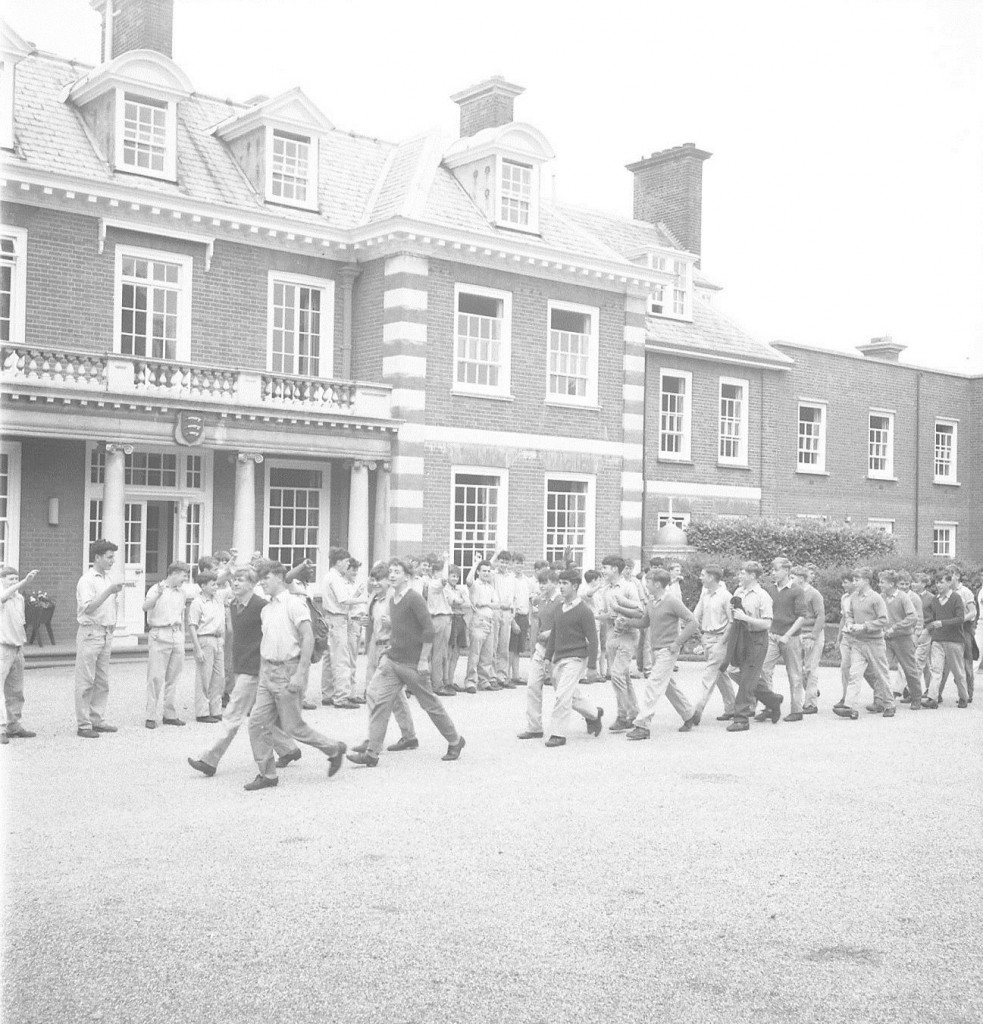
Chafford School (1965)
In 1947 Chafford Approved School transferred to Michaelstowe Hall from its original premises in Coxtie Green near Brentwood (Coxtie Green is located in Chafford Hundred, hence the school name), approved Schools were residential institutions to which young people could be sent by a court, usually for committing offences but sometimes because they were deemed to be beyond parental control. The term came into use following the 1933 Children and Young Persons Act when Approved Schools were created out of the earlier “industrial” or “reformatory” schools. They were essentially “open” institutions, modeled on ordinary boarding schools, from which it was relatively easy to abscond.
Chafford School had been established as an Approved School for boys by Essex County Council in 1942, and received its Certificate of Approval under the1933 CYP Act in August 1942. Mr. and Mrs. Harold Conway were appointed as first Head and Matron and admissions commenced in November 1942. By November 1943 fifty two boys aged 12–15 were in residence. Following the move to Michaelstowe Hall in 1947 the school gradually expanded to take a maximum of 91 boys in the 1970s, mainly from the East London area.
Full time education was provided in a block of prefabricated army huts leased from the nearby Army Transit Camp, but older boys had the opportunity to learn a trade such as painting and decorating, bricklaying, or carpentry. The school also provided excellent sporting facilities, including one of the best cricket grounds in the area.
Memories:
In the above photo the two boys at the front of the walk were the oldest ones, the one to the right use to work on the farm with me on weekends. That’s the farm that was at the back of school. I am in the middle of the above picture also in the photo was Greek lad called Mustapha and in the middle with hands in pocket with the long stride was myself, the taller lad next to me was Robert Dunn. We were in Nelson and the other class was drake.

Tony Blackburn at the Rotary Fete.
Tony Blackburn opened a fate in 1967, when he was on radio Caroline,He turned up in a yellow e type Jaguar.
We also built the extension at the back of the school, me and another lad, Michael able, put in the roof a tobacco tin with our names in and a penny. Michael Osland
Following a change of government policy during the 1980’s towards more community based services Approved Schools (now known as Community Home Schools) were in decline. By 1984 occupancy at Chafford School had fallen to only 22 and Essex Social Services Committee took the decision to close the school with effect from July 1985.
In August 1986 Michaelstowe Hall was sold by Essex County Council to Residential Care and Nursing Homes Ltd from Ipswich and the building subsequently re-opened as a Residential Care Home for the elderly. the hall is currently owned by a company known as Handylodge Ltd. and provides personal and nursing care for up to 84 older people.
Ramsey By-pass
The £ 60,000 by-pass at Ramsey was started in 1939, and was opened to traffic on the 22nd November 1961 – 22 years after work began. There was no ceremonial opening . The obstructions at either end of the by-pass were removed and motorists crept cautiously on to the new road wondering whether it would be all right to proceed. Work stopped on the by-pass at the outbreak of war in 1939 and did not start again until 1960. The uncompleted portion was camouflaged during the war in case it was mistaken by enemy airmen for a landing-strip.
The New road will take the heavy traffic on the main international highway to Parkeston Quay, also Harwich, and Dovercourt, clear of the village of Ramsey.
The narrow village street is without pavements at many points, where front doors open directly on to the narrow road. Residents have been concerned for their safety, and children attending Ramsey County Primary School have had to be taken through the village street by coach owing to traffic danger.
One hundred and fifty children attend the school from the direction of Ramsey Church, headmaster Mr F.S. Cobb said “From the school to the Castle public house will be a little bit safer, but the rest will be just as bad”.
While the opening of the new by-pass may bring joy to the motorist, it brings heartbreak for a couple who are to lose their cottage they bought for their retirement – it is to be pulled down to improve the approach to the by-pass.
Mr. and Mrs. Stanley Margrove moved from London into the cottage at the foot of Ramsey Hill just short of the entrance to the by-pass five years ago. They invested their savings to by the cottage for their retirement when they moved into the country – and now they have been told they must get out, and that they have been placed on the waiting list for a council house. Since coming to Ramey Mr. and Mrs. Margrove have built up a lot of interests in the village, if they ,move into a council house they will have fewer rooms than in their “two-cottage” home.
“We shall have to get rid of a lot of our home and we shall have no garage in a council house’ said Mrs. Margrove.
“It seems such a shame” “They are at the end of their lives. They worked and saved money and finally bought this little place to retire, and now they are going to be chucked out. They will have to start all over again.”
Ramsey Photo Gallery
Click “play” to start the gallery slide show.
Ramsey itself is a place with many links with the world at large, and because of the owners of its different manors, has played a prominent part in affairs of state, and has a very definite position in England’s long and stirring past.
Copyright Ownership
We attempted to get the consent of copyright holders to use this material for nearly all of the photographs on the website.
In the few cases where names are available, a thorough search was made using telephone directories, photographic copyright directories, People Search and Google Area Search. None of the copyright owners could be traced in this way and we believe we have exhausted all reasonable avenues.
The consensus opinion of these authorities was that if any two of the following situations applied we would be deemed to have taken sufficient action to avoid infringing copyright laws:
- Reasonable efforts made to contact the copyright holder
- No financial gain will be made in relation to the photos
- A letter is obtained from present owner of photos
- There is a proviso included stating that if offence is caused document will be removed
The website owner undertakes to remove any photograph from the website where offence is caused. All the above conditions have therefore been met.
Acknowledgments.
Harwich Society, Henry Allen, Andrew Mills, Suffolk Chronicle and Mercury 1932.

